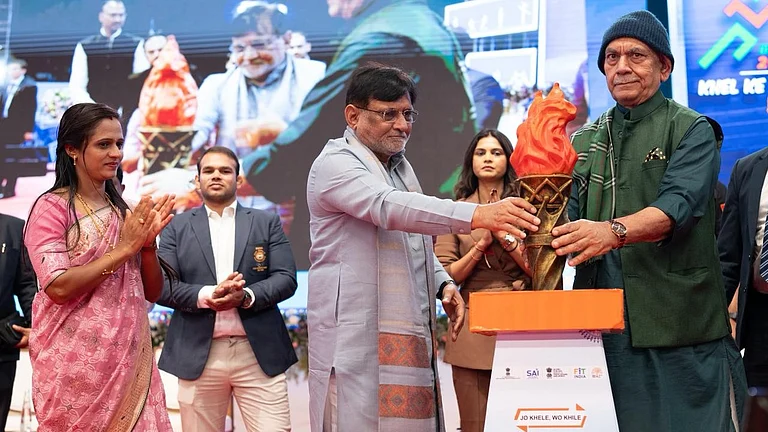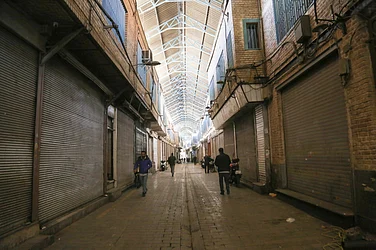I got my first mobile phone the year after Outlook began—1996. Till then, my idea of a phone was something that hung on a wall or sat on a desk. In India, you could still find big black monsters with long brown cords and dials that revolved like arthritic roulette wheels. India had about 10 million telephones in 1995, all of them connected by valuable and vulnerable copper wire. Manorama Yearbook 1995 reported that “urban subscribers…will get telephone connections on demand by 1997”. It had to be true: the Department of Telecommunications had promised it in February 1994. Satellite television had come, but it had “given birth to a new kind of letter writer”. Television programmes that offered prizes to viewers who “wrote in” generated “a record number of postcards”. And since a postcard was still 15 paise (as it had been since 1975), India Posts and Telegraphs (IP&T) lost money. Information moved sedately and mostly one-way.
This was an Old Media (OM) world. To connect with your favourite television show, you had to have the will to buy a postcard, the skill to write it and a postbox to put it in. If you were a publisher, you used a printing press or a broadcast studio. Other people paid to use your expertise and technology to sell their wares, show their talents and propagate their causes. If you ran a newspaper, you supplemented your advertising revenue by selling the paper to readers. And if your newspaper defamed someone or broke the law, you were partly responsible for the law suits and criminal charges. As long as advertising flowed in wonderful abundance, as it did in India after the economic liberalisation of 1991, it was a great time to be in newspapers or the rapidly expanding medium of television. Indian-language newspapers prospered and grew. Prime ministers began to consult their editors. “Earlier,” said Ashwini Kumar, then editor of Punjab Kesari, “politicians never used to do this sort of thing with Hindi editors.”
ALSO READ: Silver Jubilation
Old Media was one-way. Recipients accepted what the newspaper or channel offered—or found a different one. Yes, the telephone was two-way, but usually only for two people, and, anyway, India in 1995 had one telephone for every 90 people—a long queue at a call box.

The two-way digital world of New Media changed everything. The postcard survives and still costs a modest 50 paise, but IP&T lost its T in 2013 when the last telegrams were sent. India today has 1.1 billion telephone subscribers in a population of 1.3 billion. Almost all of those are mobile phones, and 700 million have broadband access—the ability to be part of the internet’s global village where everyone with a handset and a telecom provider can be a global media identity. A video of a cat can make your cat (and you) global celebrities for a moment. And evil killers can disseminate live video of vicious murders or spread outrageous lies and alarms. When we live in digital media’s global village, we also live with global village idiots.
ALSO READ: At Swim, Two Birds Perched On Latticed Sites
The New Media world looks awe-inspiringly powerful, decentralised and democratic. In fact, the internet is a fragile giant held together by spiders’ webs, and a few great players have extensive capacity to manage and influence the traffic. A government can shut down radio frequency communication, which is the essence of digital miracles. A number of governments around the world, including the government of India, have already done this when it suited them. Insurgents can destroy transmission towers. Data centres can be disrupted either by physical destruction or viruses infiltrated into their systems. The vast Google data centre at The Dalles in Oregon, described by Andrew Blum in his 2012 book Tubes, tells curious browsers: “Because we take security very seriously…, we cannot offer public tours.” Fires, floods, earthquakes and fuel shortages can disable or destroy large sections of the internet and the connectivity of users.
The internet and accompanying broadband capability have given birth to three of the greatest corporations of the 21st century: Alphabet (which owns Google and YouTube), Amazon (and its 40 or so subsidiaries) and Facebook (which owns WhatsApp and Instagram). Apple’s signature product, the iPhone, has become a household word to describe a generic item—the handheld, broadband-capable mobile phone. Governments struggle to tax and regulate the traffic these corporations enable. Taxation is tricky, because global companies shift their tax bases to countries where the rates are low. Australian governments look for ways to tax companies on the basis of their Australian digital activity and to prevent them from avoiding taxation by moving profit centres to lower-tax countries such as Singapore.
ALSO READ: The Bully Wears A Tailored Suit
The internet is full of outrageous material, and it is possible for the producers to disseminate it worldwide. Corporations such as YouTube or Instagram, who provide the platforms for users, try to prevent violence, threats and defamation from circulating. YouTube deletes about three million videos a month. Twitter and Facebook have algorithms that detect millions of rule-breaking items and stop or delete them. Facebook disables 17 million accounts every day, according to a report in the Economist.

Who makes the rules and how are they enforced? In India, the head of Facebook’s public policy division resigned after overruling her own teams and being accused of making decisions favouring the BJP. The government replied by accusing Facebook India’s teams of bias against “right-of-centre ideology,” and a minister complained that the “political biases of individuals [Facebook employees] impinge on the freedom of speech of millions of people”. Like all internet platforms, Facebook claims not to be a publisher in the Old Media sense, but merely a platform-provider trying to ensure fair play but with minimal responsibility. In China, where Facebook and its relatives are all banned, the Communist Party devotes vast resources to keeping China’s internet uncontaminated with anything that might be critical of the party. In the US, right-wing extremists invoke free-speech provisions of the Constitution when platforms delete or warn about unsubstantiated posts.
ALSO READ: In The Beginning, There Was The Spider
The US election campaign in 2016 was infiltrated by cleverly constructed, Russian-sponsored internet materials consumed by tens of millions of Americans on platforms like Facebook. And since then, the US president himself has tweeted so many blatant lies and fanciful stories that platforms like Twitter have occasionally felt obliged to tag them with cautions about their authenticity. And Republican members of Senate committees have consequently attacked executives of Facebook and Twitter for interfering with free speech.
Because of the awesome two-way quality of the broadband internet, the wackiest ideas and wildest falsifications, attractively packaged, are as accessible as the most sober discussion or research. In Old Media times, when Stalinists in Russia wanted to remove Trotsky from old photos with Lenin, it took talented air-brushing technicians and good printers to come up with convincing results. Today, an online 10-year-old using basic photo software can create slick-looking visual “truths” and send them worldwide—all the while keeping their authorship a top secret behind VPNs! India Misinformed, a book published last year by Pratik Sinha and the team at Alt News, collected scores of examples of doctored materials. At the simplest, the fakes simply inserted inflammatory text or a prurient image into a genuine photo.
ALSO READ: Can Machines Talk?
The difference with Old Media is stark. Old Media required specialised skills and equipment and were decentralised in their own peculiar way. India in the 20th century had thousands of presses and printing shops. Both Indira Gandhi and the British found it difficult to clamp down on printed material completely. Once papers, pamphlets and books get into circulation, it is difficult to recall them or to identify who has been exposed to them. The internet, on the other hand, mostly leaves digital footprints. Old Media aimed to capture a broad audience by catering to various tastes and needs. If you bought the newspaper, you got the sports, local politics, world events, crime reports and the price of onions all wrapped up in the same package. The platforms of New Media feed you what the algorithms indicate you want—crime or onions or personalised news streams that let you live in an echo-chamber where you hear only what you want to hear.
Old Media, of course, had gatekeepers who decided what would be printed, but these editor-gatekeepers also provided a measure of quality control. At their best, big city and small town newspapers had the organisational muscle to question, investigate and expose. Today, no matter how lively a local blog appears, it is unlikely to be supported by editors, lawyers, security guards, taxis home after dark and publishers prepared for a fight.
ALSO READ: Future Grid
We shouldn’t romanticise Old Media. There have been plenty of scoundrels, and the two-way capacity of New Media has helped exposed crimes that in the past would have been committed with impunity. But it has been brave reporters and sturdy managements that have given “the fourth estate” its reputation as an essential element of democracy.
Strong news organisations are shrinking and disappearing all over the world. Advertising, the lifeblood of media, has flown to the internet. With it has gone the revenue for smaller papers to survive, while bigger publications cut their editorial staffs and look for lifelines. While many courageous New Media outlets in India offer great promise, they all struggle to find a viable business model. In the New Media world, Google and Facebook make most of the advertising money, and old-style publishers vie for a much smaller pie.
ALSO READ: A To Z
Some big organisations have found ways to survive—the New York Times, Washington Post, the Guardian, the Economist, the Financial Times. But they have international audiences prepared to pay a subscription, and such an audience attracts advertisers. These publications also have well-heeled backers, like Amazon’s Jeff Bezos, owner of the Washington Post since 2013. But local newspapers are vanishing. Democracies need such news organisations, because organisations have continuity—the capacity to follow up, be relentless and support their staff.

Meryl Streep in the 2017 Hollywood film The Post, based on The Washington Post, whose new owner is Amazon’s Jeff Bezos.
In countries like Australia, the “rivers of gold”—advertisements for real estate, jobs and cars that filled weekend newspapers—disappeared onto the internet. In Melbourne, where I live, The Age sold 2.5 lakh copies a day in the early 1980s, and its Saturday edition ran to hundreds of pages. Today, The Age is a lean tabloid that sells about 75,000 copies weekdays. It claims a healthy “readership” online, but that doesn’t bring anything like the revenue that previously sustained big newsrooms of well-supported journalists. The stories produced by surviving newsrooms quickly find their way to the internet, but without payment to organisations that produced them.
ALSO READ: ...and Then They Cast The Net
In Australia, the Murdoch press, which dominates Australian print media, leads the demands that internet platforms pay news organisations for the traffic their stories bring to the platform. The current Australian government, beneficiaries of a sympathetic Murdoch press, is pressing Facebook and Google into a “news media bargaining code” which would extract some payment for the news organisations. Both Google and Facebook threaten dire consequences if such a code doesn’t please them. One way of containing the powers of the New Media giants put forward in the US is to break up the entanglement of subsidiary companies—for example, require Google and YouTube to be constituted as independent corporations, no longer under the umbrella of Alphabet. Something like this happened in the 1930s and 1940s to the radio and television industry.
In the English-speaking world, the future of printed newspapers and their once-strong advertisement revenue is bleak and uncertain. For India, however, in spite of those 700 million broadband subscribers, print-on-paper seems to have a stay of execution. The Registrar of Newspapers produced astounding figures for 2017-18 of 243 million dailies on the streets each day, more than 40 per cent of that in Hindi. The Audit Bureau, which considers the circulation only of its members, nevertheless recorded the Bengali Ananda Bazar Patrika producing over a million copies from its Calcutta presses, and the Hindi Dainik Bhaskar, with multiple printing centres, printing 4.2 million copies a day, the highest circulation in India. Most print companies, however, have been preparing for a post-print future, just as big television companies have been focusing on digital distribution and consumption.
ALSO READ: gOoD eNgLiSh? WTF is that? ¯\_(ツ)_/¯
Living another day is one thing, living to fight quite another. India has slipped to 142nd on the Press Freedom list of 180 countries prepared by Reporters without Borders. The new efforts of India’s I&B Ministry to oversee internet material is unlikely to improve that ranking and will give governments further powers to pursue people and organisations that offend them.
The internet was once seen as a liberating force, removing control of information from the one-way gatekeepers and giving it to “the people” in a revolutionary way. While some of that is true, we increasingly see the pitfalls and biases and immense power lying with a few supranational entities. The investment this year, for example, of over $10 billion in Reliance Jio by Facebook and Google gives Mark Zuckerberg, Jeff Bezos and Mukesh Ambani a common interest in the welfare of their digital empires.
Meanwhile, the humble postcard at 50 paise a pop still has its uses. India Post reported that it carried 870 million of them last year.
ALSO READ
Robin Jeffrey, Visiting Research Professor at the Institute of South Asian Studies, Singapore, is the author of India’s Newspaper Revolution and co-author with Assa Doron of Cell Phone Nation and Waste of a Nation: Garbage and Growth in India.






















